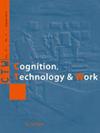Improvements in musculoskeletal symptoms, mental workload and mental fatigue: Effects of a multicomponent ergonomic intervention among call center workers.
IF 3.4
3区 工程技术
Q2 ENGINEERING, INDUSTRIAL
引用次数: 3
Abstract
BACKGROUND Call center workers are highly susceptible to work-related musculoskeletal disorders (WRMSDs) as well as mental stress. Nonetheless, there has been a surprising paucity in the body of the research regarding interventions among call center workers. OBJECTIVE The purpose of this paper is to investigate the effectiveness of a multicomponent ergonomic intervention program on mental workload, mental fatigue and WRMSDs of call center employees. METHOD A non-randomized interventional study with a single group pretest-posttest design was conducted among 84 call center workers of a private telecommunication company in the city of Tehran, Iran. At the baseline, data regarding WRMSDs prevalence, mental workload and mental fatigue were collected by means of standard Nordic, NASA-TLX and SOFI questionnaires, respectively. Then, subjects participated in a multifaceted intervention program including comprehensive office ergonomic training, work layout improvement, supervised on-site face to face visits, and provision of quality break time encompassing regular exercise program. Follow-up assessment was carried out after 6 months. RESULTS After the intervention, prevalence of WMSDs in the neck (10% , P = 0.022), lower back (8.4% , P = 0.04), and knees (9.5% , P = 0.02) decreased significantly, while improvements in other body areas remained insignificant. Results also showed a significant decrease in overall score of mental demand (P = 0.000) as well as three of its subscales including performance (P = 0.02), effort (P = 0.001), and frustration (P = 0.025). Additionally, positive effect of the intervention was also observable on overall mental fatigue of call center workers (P = 0.016). As for its subscales, Lack of energy was reported to decrease meaningfully (P = 0.007) while lack of motivation did not change significantly (P = 0.240). CONCLUSION Although the primary focus of many ergonomic interventions has remained to measure physical outcomes of the work place, our findings show that multicomponent interventions are indeed capable of boosting cognitive aspects of the work as well. The future studies should consider investigating such outcomes.肌肉骨骼症状、精神负荷和精神疲劳的改善:呼叫中心工作人员多组分人体工程学干预的影响
呼叫中心工作人员非常容易患上与工作相关的肌肉骨骼疾病(WRMSDs)以及精神压力。然而,令人惊讶的是,关于呼叫中心员工干预的研究却少之又少。目的探讨多组份人机工程学干预方案对呼叫中心员工精神负荷、精神疲劳和wrmsd的影响。方法采用单组前测后测设计,对伊朗德黑兰市一家私营电信公司的84名呼叫中心工作人员进行非随机干预研究。基线时,分别采用北欧标准问卷、NASA-TLX问卷和SOFI问卷收集WRMSDs患病率、精神负荷和精神疲劳数据。然后,受试者参与了一个多方面的干预项目,包括全面的办公室人体工程学培训,工作布局改善,监督现场面对面访问,以及提供高质量的休息时间,包括定期锻炼项目。6个月后进行随访评估。结果干预后,颈部(10%,P = 0.022)、下背部(8.4%,P = 0.04)和膝关节(9.5%,P = 0.02)的WMSDs患病率明显下降,其他部位改善不显著。结果还显示,心理需求总分(P = 0.000)以及表现(P = 0.02)、努力(P = 0.001)和挫折(P = 0.025)三个分量表得分均显著下降。此外,干预对呼叫中心工作人员整体心理疲劳也有显著的正向影响(P = 0.016)。在其各分量表中,缺乏能量有显著性下降(P = 0.007),而缺乏动机无显著性变化(P = 0.240)。结论:尽管许多人体工程学干预的主要焦点仍然是测量工作场所的身体结果,但我们的研究结果表明,多组分干预确实能够促进工作的认知方面。未来的研究应该考虑调查这些结果。
本文章由计算机程序翻译,如有差异,请以英文原文为准。
求助全文
约1分钟内获得全文
求助全文
来源期刊

Cognition Technology & Work
ENGINEERING, INDUSTRIAL-
CiteScore
6.90
自引率
7.70%
发文量
26
审稿时长
>12 weeks
期刊介绍:
Cognition, Technology & Work focuses on the practical issues of human interaction with technology within the context of work and, in particular, how human cognition affects, and is affected by, work and working conditions.
The aim is to publish research that normally resides on the borderline between people, technology, and organisations. Including how people use information technology, how experience and expertise develop through work, and how incidents and accidents are due to the interaction between individual, technical and organisational factors.
The target is thus the study of people at work from a cognitive systems engineering and socio-technical systems perspective.
The most relevant working contexts of interest to CTW are those where the impact of modern technologies on people at work is particularly important for the users involved as well as for the effects on the environment and plants. Modern society has come to depend on the safe and efficient functioning of a multitude of technological systems as diverse as industrial production, transportation, communication, supply of energy, information and materials, health and finance.
 求助内容:
求助内容: 应助结果提醒方式:
应助结果提醒方式:


